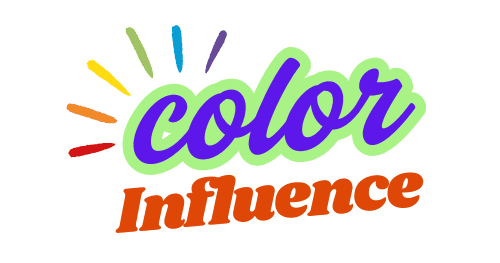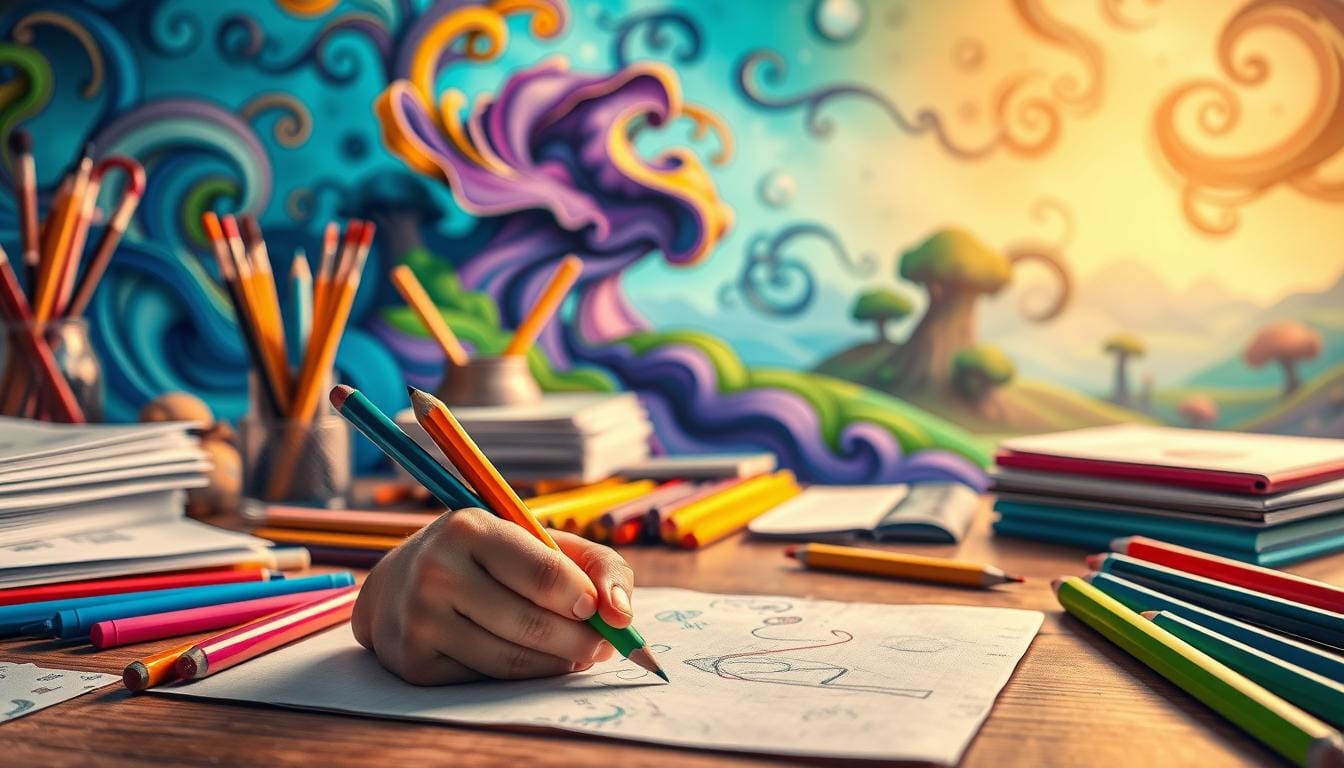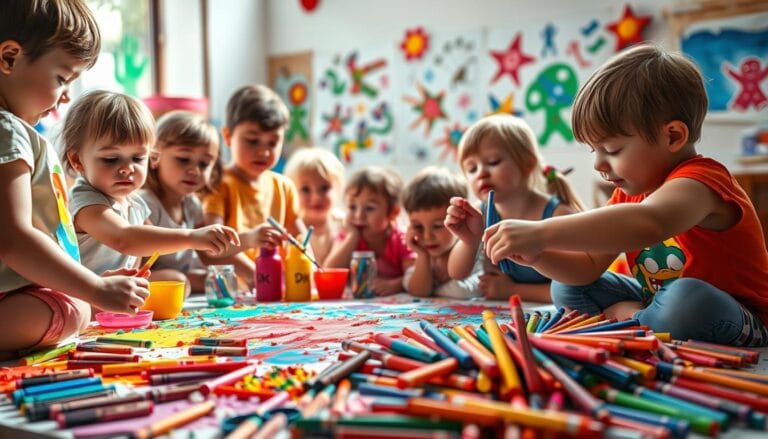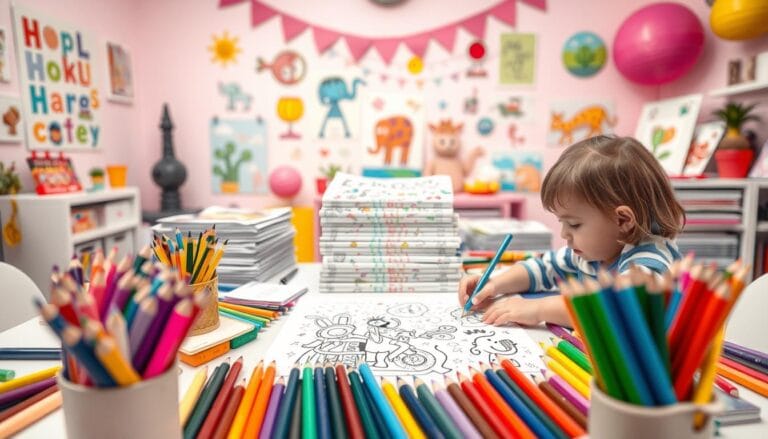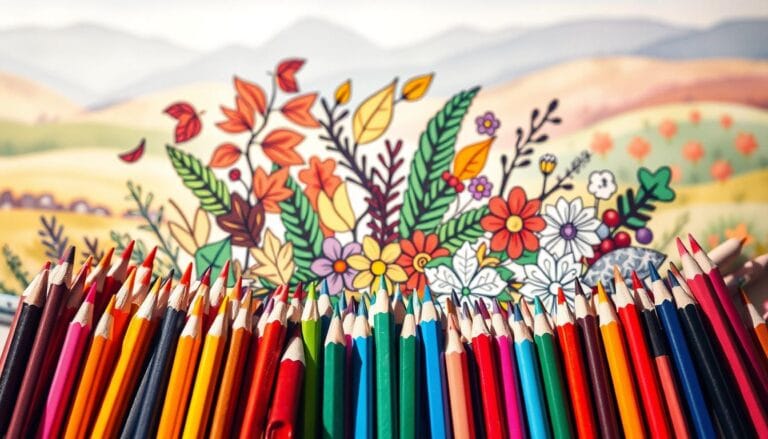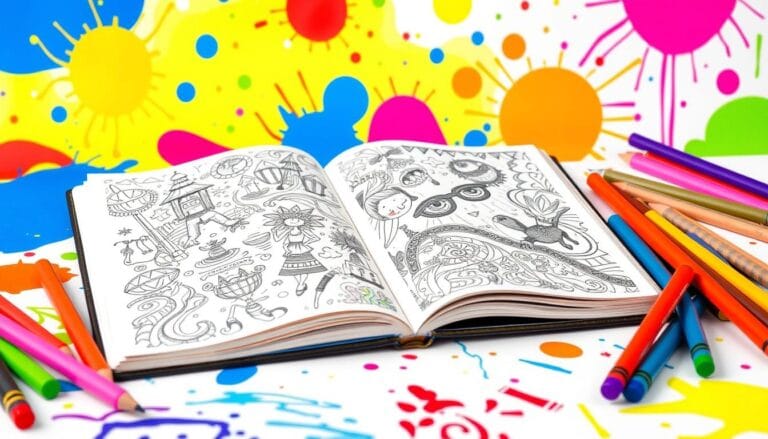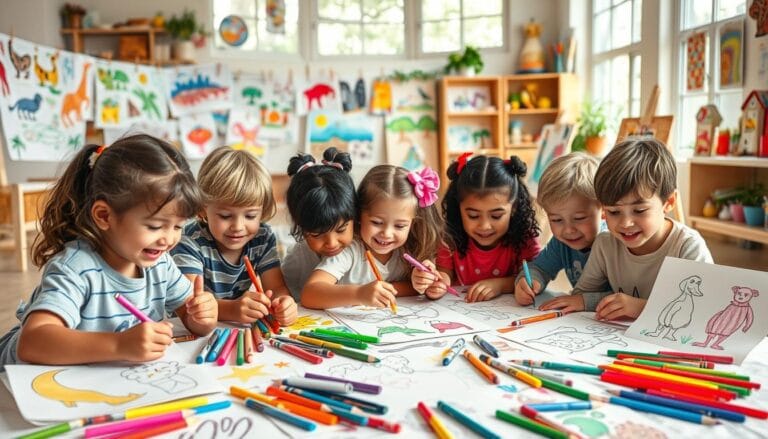How Coloring Elevates Learning and Sparks Imagination
Do you remember when a blank page turned into a colorful world through your coloring books? Coloring is more than just fun. It’s a powerful tool that boosts learning and sparks creativity. Your creativity is not just about adding colors. It’s a way to grow your mind and feel emotions.
Coloring books are more than fun. They are learning tools where kids connect colors with words. This helps them recognize and understand colors better. By coloring, you’re not just making art. You’re building important brain paths for learning.
Think about how a simple crayon can change education. Coloring lets students explore ideas and feelings in a new way. It’s a language that everyone can understand, no matter their age or skill.
The Science Behind Coloring and Brain Development
Coloring is more than just a hobby. It’s a powerful tool for brain growth that engages your mind in amazing ways. Neuroscience shows how this activity boosts mental stimulation and supports complex brain paths.
Neural Pathways and Creative Expression
Coloring makes your brain create detailed connections that boost creativity and thinking skills. Research offers interesting views on how color affects brain activity:
- Blue environments can lower blood pressure and improve problem-solving skills
- Green briefly glimpsed can increase creative performance
- Yellow stimulates mental activity and encourages innovative thinking
Color Psychology in Learning
Colors are key in how we see and understand information. Different colors trigger unique feelings that can greatly affect learning:
| Color | Psychological Impact |
|---|---|
| Blue | Enhances focus and calm |
| Red | Increases alertness and attention to detail |
| Green | Promotes relaxation and creativity |
Cognitive Benefits of Regular Coloring
Coloring offers big brain benefits. Regular coloring can improve memory, boost problem-solving skills, and enhance mental flexibility. A study at the University of British Columbia found that red can increase detail-oriented task performance by 31%, showing color’s big impact on brain function.
Coloring is not just an art—it’s a science of brain development and creative expression.
Essential Motor Skills Development Through Coloring
Coloring is more than just a fun activity for kids. It’s a powerful tool for developing critical motor skills. When a child picks up a crayon, they start a complex learning process. This process strengthens their physical and cognitive abilities.
The act of coloring builds fine motor skills in several ways:
- Improving hand-eye coordination
- Developing grip strength
- Enhancing precision and control
- Practicing spatial awareness
As kids move from random scribbling to controlled coloring, they develop important motor skills. These skills prepare them for future academic tasks. The pincer grasp, crucial for writing, becomes more refined with coloring practice.
Research shows that coloring has long-term benefits. Kids who color regularly show better:
- Pencil control
- Bilateral hand coordination
- Visual motor integration
- Spatial reasoning skills
For parents and educators, coloring is a fun way to support education and motor skill development. By offering different coloring experiences, you help kids build the skills they need for writing and other precise tasks.
How Coloring Elevates Learning and Sparks Imagination
Coloring is more than a fun activity. It’s a powerful tool for learning and creative expression. When children use colors and images, they open up new ways of thinking and imagining.
Imagine a blank page turning into a world full of color. Research shows 85% of educators believe coloring boosts creativity and imagination in kids. Your child’s coloring can really help their brain grow.
Visual Learning Enhancement
Coloring is a special way to learn visually. Kids learn about colors and staying inside lines. This helps them with:
- Spatial awareness
- Color recognition skills
- Attention to detail
“Coloring is a child’s first language of creativity” – Unknown
Creative Problem-Solving Development
Coloring helps kids make choices and find different solutions. Interestingly, 40% of kids showed better problem-solving skills after coloring.
Memory and Retention Improvement
Studies show kids who color remember things 30% better. By making visual memories with color, your child can learn more and connect ideas better.
Coloring is more than just an activity. It’s a way to spark imagination and make learning more fun for kids.
Color Recognition and Pattern Understanding
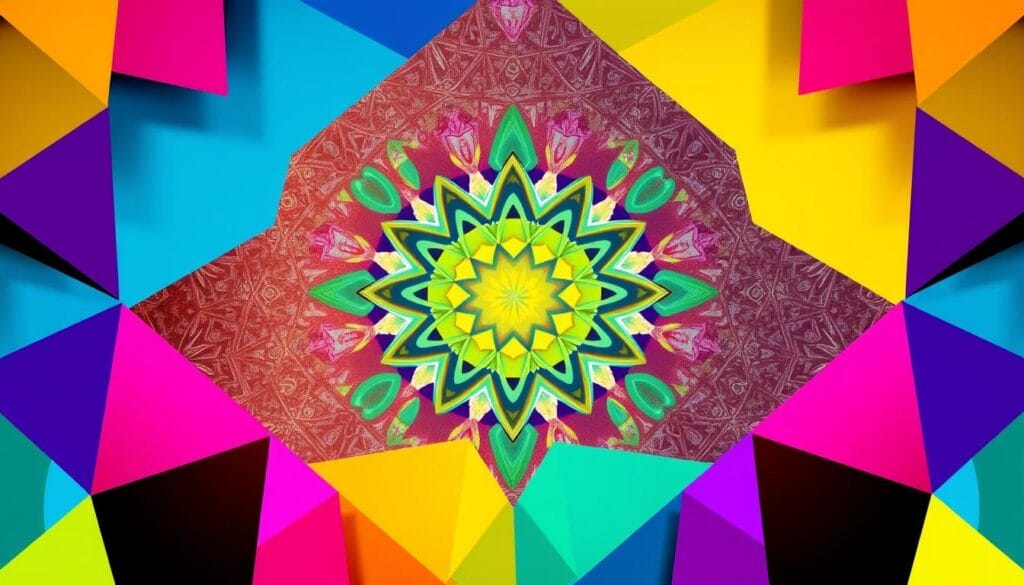
Coloring is a great way for kids to learn about colors and patterns. It helps them see the world in a new light. They start to understand colors and patterns better.
Through coloring, kids get better at recognizing patterns. This skill is important for their brain. It helps them in many ways:
- Developing spatial awareness
- Enhancing visual discrimination skills
- Understanding complex visual relationships
- Improving problem-solving capabilities
Math starts to make sense when kids explore patterns. Cultural patterns and designs teach them about symmetry and more. They get to see over 100 pattern coloring pages, which helps them think critically.
As kids color, they learn to connect colors with things. They also try out different color mixes. Studies show that certain patterns can make them feel calm or spark their creativity.
Coloring helps kids grow in many ways. It:
- Improves hand-eye coordination
- Strengthens fine motor skills
- Expands visual perception
- Encourages artistic expression
Patterns are not just visual elements, but fundamental building blocks of understanding the world around us.
Coloring helps kids learn important skills. These skills are not just for art. They help kids learn and grow in many areas.
Emotional Expression and Stress Relief Benefits
Coloring is a powerful way to heal emotions and reduce stress. It acts as a universal language, especially for those who find it hard to express their feelings. This is true for both kids and adults.
Coloring can greatly lower stress by calming the brain’s fear center, the amygdala. It turns emotions into pictures, creating a safe space for healing and self-reflection.
Managing Emotions Through Art
Coloring has many emotional benefits:
- Reduces anxiety and depressive symptoms
- Promotes mindfulness and present-moment awareness
- Generates a sense of achievement and pride
- Offers emotional catharsis
Creating Safe Spaces for Self-Expression
Coloring is a way to express feelings without words. The repetitive actions can lead to a meditative state, like mindfulness.
| Emotional Benefit | Psychological Impact |
|---|---|
| Flow State | Reduces stress, enhances joy |
| Neural Stimulation | Improves cognitive flexibility |
| Emotional Processing | Builds resilience |
Therapeutic Applications in Education
Schools and counseling programs are using coloring to help with emotional control. It’s a creative activity that helps students manage stress and develop emotional smarts.
Whether facing work stress, school pressure, or personal issues, coloring is a simple yet powerful way to practice mindfulness and explore emotions.
Building Focus and Concentration Skills

Coloring is a special way to improve your mind and focus. It changes how you think about staying focused. This simple activity can bring big benefits to your brain.
Studies show that coloring boosts your concentration. The calm, steady motion helps your brain stay sharp. Blue colors are especially good for your brain, making you more focused.
- Improves sustained attention
- Reduces mental clutter
- Promotes mindfulness practices
- Enhances cognitive flexibility
Coloring puts your brain in a special flow state. This state lets you focus deeply without feeling stressed. It makes your brain stronger, helping you tackle life’s challenges.
| Cognitive Benefit | Impact on Focus |
|---|---|
| Reduced Mental Fatigue | Increases sustained attention span |
| Stress Reduction | Improves overall mental clarity |
| Mindfulness Practice | Enhances present-moment awareness |
Adding coloring to your daily life is a smart move. It’s a gentle way to sharpen your brain. This makes staying focused easier and more natural.
Social Development and Collaborative Learning
Childhood education is all about sharing and learning together. Coloring is a special way for kids to improve their social skills. It encourages them to work together and be creative.
Group coloring projects are great for kids to bond and grow. Studies show that playing together helps kids develop important social skills.
Group Coloring Activities
Collaborative coloring changes the classroom into a place where everyone feels important. When kids work on art together, they:
- Learn teamwork skills
- Practice sharing materials
- Develop mutual respect
- Explore different perspectives
Sharing and Communication Skills
Talking about their coloring choices helps kids share their thoughts and feelings. For those who find it hard to speak, art is a powerful way to express themselves. Approximately 4.4 million children ages 3-17 have been diagnosed with anxiety, making art very important for their emotional health.
Peer Learning Opportunities
Collaborative coloring lets kids learn from each other. They see new techniques, share ideas, and boost each other’s creativity. This way of learning helps kids develop important social skills in a fun way.
Art is not just about creating something beautiful, but about connecting with others and understanding ourselves.
By adding group coloring to the classroom, teachers can help kids grow socially and emotionally. It builds a sense of community and support among students.
Conclusion
Coloring is more than just a fun activity. It’s a powerful tool for learning and growing. It changes how kids see and interact with the world.
When kids color, they’re not just making art. They’re building important skills like problem-solving and creativity. They also improve their focus and understanding of space.
Using coloring as a learning tool can really help kids grow. It’s great for both structured classes and free time at home. It helps kids think creatively and understand their feelings better.
Every time your child colors, they’re learning something new. Your support makes coloring a special way for them to learn and grow. It prepares them for school and life ahead.
FAQ
At what age can children start benefiting from coloring activities?
Kids can start with coloring around 18 months to 2 years old. At this age, they learn to use their hands and recognize colors. As they get older, coloring helps them think creatively and express their feelings.
How does coloring impact brain development?
Coloring makes the brain work hard, creating new paths and boosting creativity. It uses the brain’s top layer, improving focus and using both sides. This helps with solving problems, understanding space, and recognizing patterns.
Can adults benefit from coloring activities?
Yes! Adult coloring is great for reducing stress and improving focus. It’s like meditation, helping to calm the mind and boost creativity. Many adults find it relaxing and stimulating for their minds.
How does coloring improve motor skills?
Coloring helps kids use their hands better, improving control and coordination. As they get better, they learn to hold pencils and write more clearly. This is key for many everyday tasks.
Can coloring help with learning difficulties?
Yes, coloring is helpful for kids with learning challenges. It boosts thinking skills, focus, and is a way to express feelings without words. It’s especially good for kids with attention or sensory issues.
What types of coloring activities are most beneficial for learning?
Best coloring activities include complex patterns, educational books, mandalas, and group projects. These activities help with solving problems, recognizing patterns, and understanding colors. They also encourage teamwork and learning.
How often should children engage in coloring activities?
Experts say to color regularly, but not too long. Young kids should color for 15-30 minutes a few times a week. It’s important to make it fun and not push them too hard.
Are digital coloring apps as beneficial as traditional coloring?
Digital apps have some benefits, but traditional coloring is better for kids. It helps with motor skills, gives a tactile experience, and cuts down on screen time. Apps can be a fun addition, though.
How does coloring support emotional intelligence?
Coloring is a great way to express feelings without words. It helps kids deal with emotions, lowers stress, and teaches them to control their feelings. It’s a calming activity that helps kids understand themselves better.
